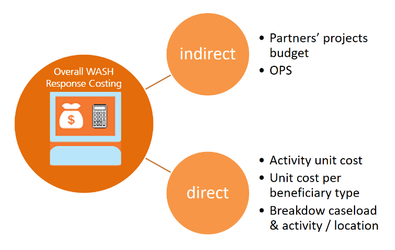...
Estimate the overall WASH response funding requirements
The HRP is also a funding funds raising appeal document, where funding requirements of each cluster are presented separately and consolidated to form the total funding requirement for the response. Each sector coordinator is responsible to estimate the budget needed to implement the sectorial strategy for the coming year/phase. This is a complicated task as many parameters must be considered, and many variables are still unknown during planning phase (material cost, logistic cost...), which can change the overall budget. Nevertheless, response costing must be done quickly enough for funding to be allocated without delay. Even if estimates are roughwhen costs are roughly estimated, it is important to be transparent and be able to explain how figures were it was calculated. Cluster response budgets also represent targets against which funding allocation level will be regularly measured. Such monitoring of the funding status is used to advocate for further efforts in resource mobilization efforts during throughout the response when necessary.
| Response costing method |
As defined shown in the diagram above, there are two ways for WASH Cluster coordinators to estimate WASH response budget as:
1- Indirect costing: In protracted emergencies , in (usually around September), partners are requested to summarize and upload a summary of their planned projects for the next year on the OPS website. Cluster coordinators can be asked to pre-validate their projects making sure they meet minimum criteria. Operational Response Plan’s costs can be calculated by adding up requested budgets from all approved partner’s planned proposals. This method can be used in sudden onset emergencies. The positives and negatives of this include:
...
| Note | ||
|---|---|---|
| ||
|
| Tip | ||
|---|---|---|
| ||
OPS (Online Project System), where cluster partners are requested to upload a summary of their planned project for next year |
